
There are many castles remaining in Japan, which continue to fascinate many history fans. The FUN! JAPAN editorial team has so far introduced the "Top 10 Castles to Visit", "12 Existing Castles in Japan", "5 National Treasure Castles", and the "Three Great Night Castles of Japan". This time, we will introduce practical information that you should know before visiting, such as the highlights, access, and ticket purchase methods of Osaka Castle, Kumamoto Castle, and Nagoya Castle, which are known as the three great castles of Japan.
※A portion of the sales may be returned to FUN! JAPAN when you purchase or reserve the products introduced in the article.
What are the Three Great Castles of Japan?
The Three Great Castles of Japan refer to the top three castles among the many built in Japan. As a guideline for the cultural value of castles, there is the "Japan's Top 100 Castles" selected by the Japan Castle Foundation with the support of the Ministry of Education, Culture, Sports, Science and Technology and the Agency for Cultural Affairs. However, the Three Great Castles of Japan are not officially selected by such public organizations. Generally, Osaka Castle in Osaka Prefecture, Kumamoto Castle in Kumamoto Prefecture, and Nagoya Castle in Aichi Prefecture are often considered the three great castles, but sometimes Himeji Castle in Hyogo Prefecture or Matsumoto Castle in Nagano Prefecture may replace one of these castles, depending on the persons or regions.
Osaka Castle: The Landmark of Osaka Built by Toyotomi Hideyoshi
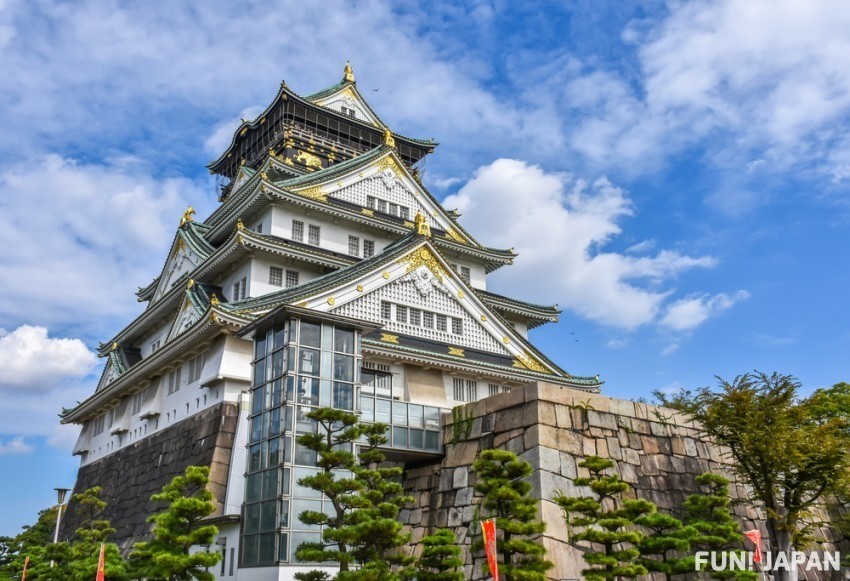
Osaka Castle, built by Toyotomi Hideyoshi, a warlord of the Sengoku and Azuchi-Momoyama periods in Japan, served as the base for his unification of the country. Hideyoshi chose to build the castle in Osaka, a city with promising future development, and by developing the castle town, he aimed to demonstrate his power to the world. It is said that the castle was completed in about three years, with tens of thousands of people mobilized to dig moats in two or three layers. The castle tower, which stands about 32 meters high from the foundation stone, and is surrounded by an inner and outer moat each about 50 meters wide, was considered an impregnable fortress.
However, in the battles of "Osaka Winter Siege Campaign" from November to December in 1614 and "Osaka Summer Siege Campaign" from April to May in 1615, Toyotomi Hideyoshi and Tokugawa Ieyasu fought around the castle, and with Tokugawa Ieyasu's victory, the Toyotomi side was destroyed. Afterwards, in 1620, the castle was rebuilt over a period of 10 years by order of Tokugawa Hidetada.
Because the current Osaka Castle was rebuilt on the site of the Toyotomi-era castle by piling up several meters of soil, it is said that the stone walls from the Toyotomi era are still buried deep underground. The current castle tower was restored in 1931, survived the air raids of World War II, and remains to this day.
Highlights of Osaka Castle: The castle tower displaying historical materials. Also famous as a cherry blossom spot
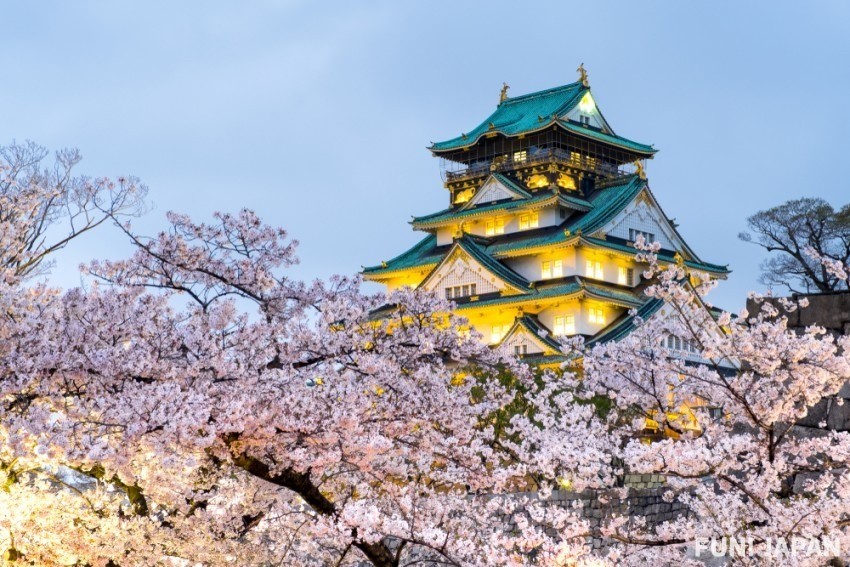
The castle tower, which was rebuilt in 1931, is now a historical museum. The 3rd and 4th floors feature the theme of "Toyotomi Hideyoshi and His Era", introducing materials from the Sengoku (Warring States) period, including items related to Hideyoshi. The 5th floor introduces the world of "Osaka Summer Siege Folding Screen" in an easy-to-understand manner using videos and miniature models. From the observatory on the 8th floor, 50 meters above the ground, you can overlook Osaka Castle Park and the cityscape of the Osaka Plain. In addition, about 3,000 cherry trees are planted in Osaka Castle Park, so you can enjoy cherry blossom viewing during the cherry blossom season.
Osaka Castle Facility Overview
- Address: 1-1, Osaka Castle, Chuo-ku, Osaka 540-0002
- Opening hours: The castle tower is open from 9:00 to 17:00 (admission until 16:30)
- Official site: https://www.osakacastle.net/
Access to Osaka Castle & How to Buy Tickets
Nearest station to Osaka Castle
Osaka Metro
- Tanimachi Line "Tanimachi 4-chome" Station Exit 1-B, "Temmabashi" Station Exit 3
- Chuo Line "Tanimachi 4-chome" Station Exit 9, "Morinomiya" Station Exit 1, Exit 3-B
- Nagahori Tsurumi-ryokuchi Line "Morinomiya" Station Exit 3-B, "Osaka Business Park" Station Exit 1
JR
- Osaka Loop Line "Morinomiya" Station, "Osaka Castle Park" Station
- Tozai Line "Osaka-jo-kitazume" Station
Keihan Electric Railway
- Keihan Electric Railway "Temmabashi" Station
Water Bus
- "Osaka Castle Port Yakenohama Landing"
Osaka City Bus
- "Osaka Castle Otemae", "Babacho" [Route 62]
- "Osaka Station - Yodoyabashi - Temmabashi - Osaka Castle Otemae - Babacho - Abenobashi - Sumiyoshi Garage Mae"
Access from Major Stations
①Umeda Station・Osaka Station
From Osaka Station, take the JR Osaka Loop Line in the direction of Kyobashi/Tsuruhashi for about 10 minutes and get off at "Osaka Castle Park" station.
※If you are at Umeda Station, it's a 5-minute walk to "Osaka" station
②Shinsaibashi・Namba
From Namba Station, take the OsakaMetro Midosuji Line for about 1 minute, change at "Shinsaibashi" station to the OsakaMetro Nagahori Tsurumi-ryokuchi Line and ride for about 8 minutes, then get off at "Morinomiya" station.
③Tennoji
From Tennoji Station, take the JR Osaka Loop Line (inner loop) for about 9 minutes and get off at "Morinomiya" station.
How to buy tickets
①On-site: Tickets are sold at the entrance ticket office of the castle tower. However, as it can get crowded, we recommend purchasing in advance online.
②Web: Single admission ticket for Osaka Castle Tower (valid for 3 months). On the day, go to the entrance ticket office 'No. 2' of the castle tower
③ 👉 [Japan] Osaka Castle: Main Tower | Admission E-Ticket
👉 Osaka daytime helicopter cruising/sightseeing flight (4 minutes, 7 minutes, 10 minutes course)
Kumamoto Castle: The castle tower is fully restored. To the castle where restoration work is progressing
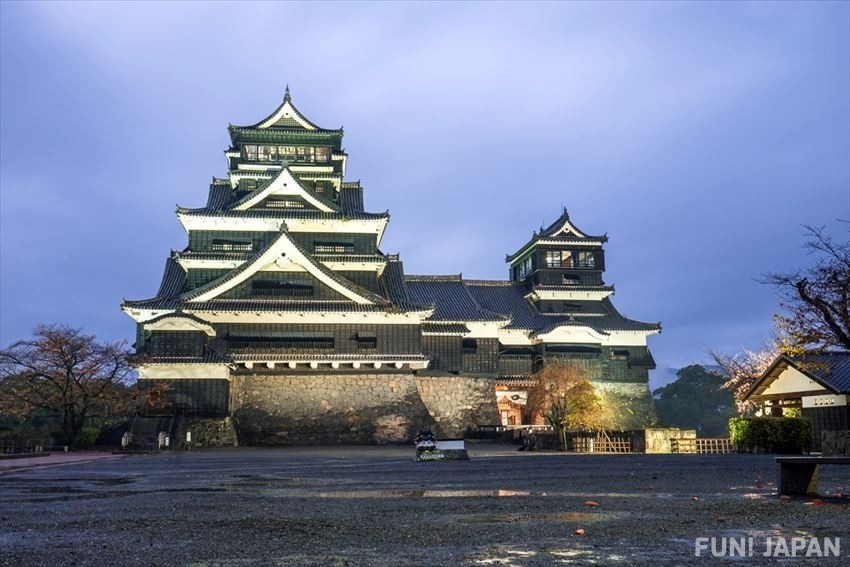
Kumamoto Castle, built over approximately seven years by Kato Kiyomasa, a warrior of the Azuchi-Momoyama and early Edo periods who served Toyotomi Hideyoshi. The more you look up, the more the stone walls curve back, making it impossible to climb, a feature known as "musha-gaeshi" (sending back warriors). It is also famous as an impregnable castle. In 1877, the castle tower and the main enclosure's residence were destroyed by fire.
In 1933, Uto Yagura turret and 12 other buildings were designated as National Treasures, and the stone walls and moats were designated as Historic Sites. The Kumamoto Castle tower was restored in 1960, but it was severely damaged in the 2016 Kumamoto earthquake. Restoration work on the tower began in 2017 and was completed in 2021. In addition, the Uto Yagura, the main exclosure residence's grand hall, and the South Otemon Gate are currently being restored.
There are areas that cannot be toured on foot, but it is also valuable to be able to view the Kumamoto Castle under reconstruction.
Highlights of Kumamoto Castle: The fully restored tower is a must-see!
The highlight is the tower, which was fully restored in March 2021. You can enjoy the completely renewed exhibition and the view from the top floor. The exhibition space focuses on the history of the "tower" of Kumamoto Castle, and introduces the construction, destruction in the Seinan War, reconstruction of the tower, and the damage and recovery from the Kumamoto earthquake in an easy-to-understand manner using videos and models. From the top floor, you can overlook the Kumamoto Castle and the city of Kumamoto, which are under reconstruction, and the mountains of Aso in the distance. Using the AR function of the smartphone app, you can overlay old photos taken in the early Meiji era on the current scenery.
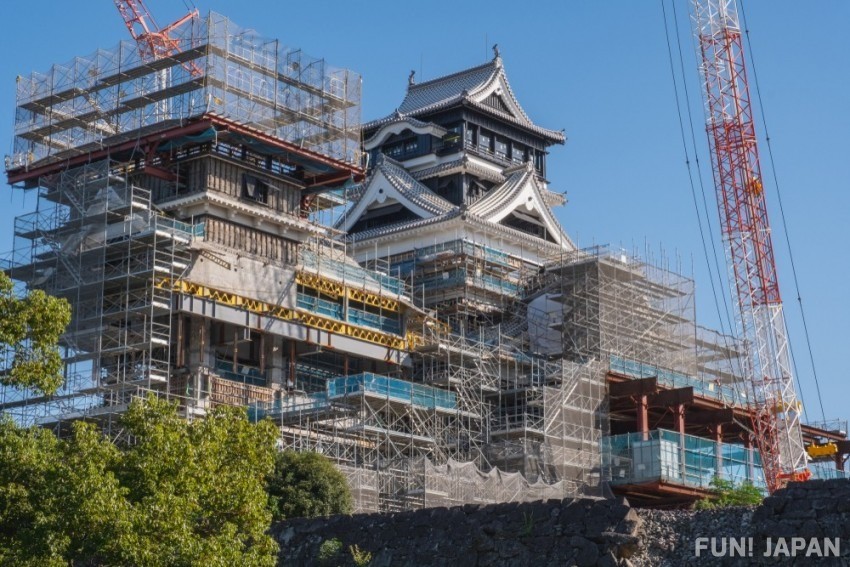
The Kumamoto earthquake, which occurred on April 14, 2016, caused extensive damage. At Kumamoto Castle, all 33 facilities on the premises suffered damage, such as falling tiles and collapsing towers. The stone walls, a symbol of Kumamoto Castle, suffered damage in more than half of the approximately 1,000 faces, with 517 faces collapsing or bulging. It is said that about 100,000 stones need to be restacked.
For the restoration of the stone walls, it is necessary to return the collapsed stones to their original places correctly, and craftsmen are working on it. However, they can only stack about three stones per day, so they have to continue this daunting task.
As of June 2024, the castle tower, the main enclosure residence's large hall, the long wall, and the watchtower have been fully restored, but full restoration is expected to be completed in the fiscal year 2052. When visiting, please be careful not to enter prohibited areas and follow the route for sightseeing.
Overview of Kumamoto Castle
- Address: 1-1, Honmaru, Chuo-ku, Kumamoto City, Kumamoto Prefecture, 860-0002
- Business hours:
- 9:00~17:00 (Last admission 16:30)
- ※Admission to the castle tower is until 16:30
- ※Opening hours may be extended due to events, etc.
- ※From October 1, 2022, only the south entrance will be used on weekdays, and both the north and south entrances can be used on Saturdays, Sundays, and holidays
- Closed: Year-end (December 29th to December 31st)
- Admission fee: 800 yen
- Official website: https://castle.kumamoto-guide.jp/
Access to Kumamoto Castle & How to Buy Tickets
- Take the city tram from Kumamoto Station for about 17 minutes, get off at "Kumamoto Castle / City Hall Mae", and walk for about 10 minutes,
- Take the bus from Kumamoto Station for about 10 minutes, get off at "Sakuramachi Bus Terminal", and walk for about 10 minutes
- Take the "Kumamoto Castle Tour Bus Shiromegurin" from Kumamoto Station, get off at "Kumamoto Castle (Ninomaru Parking Lot, Ninomaru Square)" after about 30 minutes
What is the "Kumamoto Castle Tour Bus Shiromegurin"?
A convenient ticket for touring Kumamoto Castle and its surrounding facilities from Kumamoto Station. No matter where you get on or off, it's 180 yen. The Kumamoto Castle Loop Bus One-Day Pass comes with discount coupons for each facility. The admission fee for Kumamoto Castle is 800 yen, but with this, it's 640 yen. The fare is 180 yen per ride, and the one-day pass is 500 yen.
How to buy tickets: On-site OR Official Website (WEB Ticket)
On-site: Purchase at the ticket office (4 locations). In addition to credit cards, electronic money, QR code payment (WeChatPay, ALIPAY, PayPay, au PAY, d payment, Merpay, Rakuten Pay, etc.) are accepted.
- South Exit Ticket Office (9:00~16:00)
- North Exit Ticket Office (8:45~16:00) *Available only on Saturdays, Sundays, and holidays
- Ninomaru Ticket Office (8:45~16:00)
- Wakuwakuza Ticket Office (8:45~16:00)
Web: If you have decided on the date and time of your visit, you can pre-purchase the admission ticket (electronic ticket) on the WEB. After the purchase is completed, the electronic ticket (two-dimensional code) will be sent to your registered email address.
On the day of your visit, please display the QR code on your smartphone or bring a printed copy of the QR code at the entrance. Cancellations or changes in date/time are not allowed after purchase.
Nagoya Castle: A major tourist attraction in Nagoya, familiar with the golden Shachi decorating the castle tower
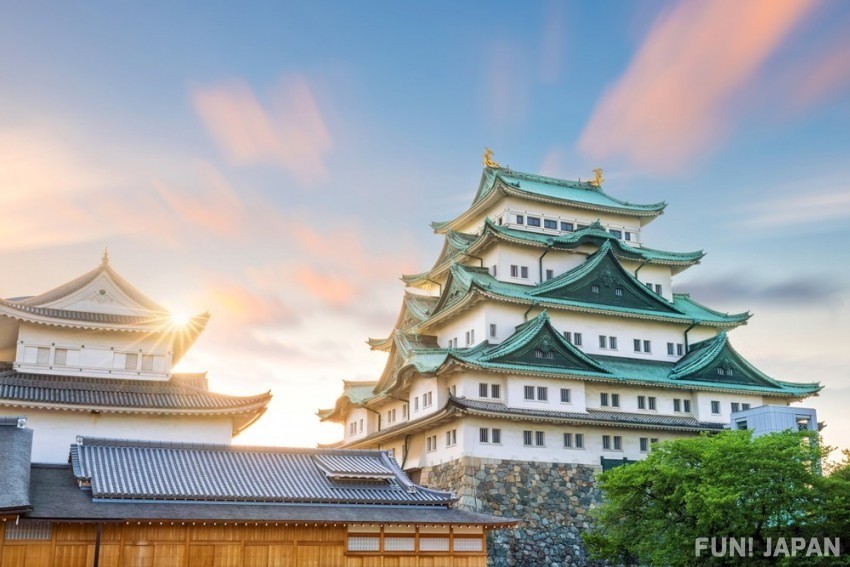
The castle built by Tokugawa Ieyasu, a Japanese warlord from the Sengoku period to the early Edo period and the first shogun of the Edo shogunate, as the final step towards unifying Japan. The castle was built in 1612. Its symbol is the golden Shachihoko adorning the roof of the massive keep. There are two, male and female, and the "Golden Shachihoko" made of pure gold is said to have been made by Tokugawa Ieyasu to demonstrate his dignity as the ruler to the daimyo. Most of it was destroyed in the Nagoya air raid in 1945, but it was rebuilt in 1959.
On the 1st to 5th floors of the main keep, you can see various exhibits related to Nagoya Castle. The Main Enclosure Residence (Honmaru Goten) of Nagoya Castle, which was once designated as a National Treasure as a castle, was so great that it was called "the masterpiece of early modern castle residences", but it was damaged by war.
However, based on the remaining documents, actual measurements, old photographs, and barrier paintings, restoration work began in 2009 and was completed in 2018. However, as of June 2024, it is closed to enhance its earthquake resistance.
Highlights of Nagoya Castle: Main Enclosure Residence & Gourmet Alley in the basement of Nagoya Castle
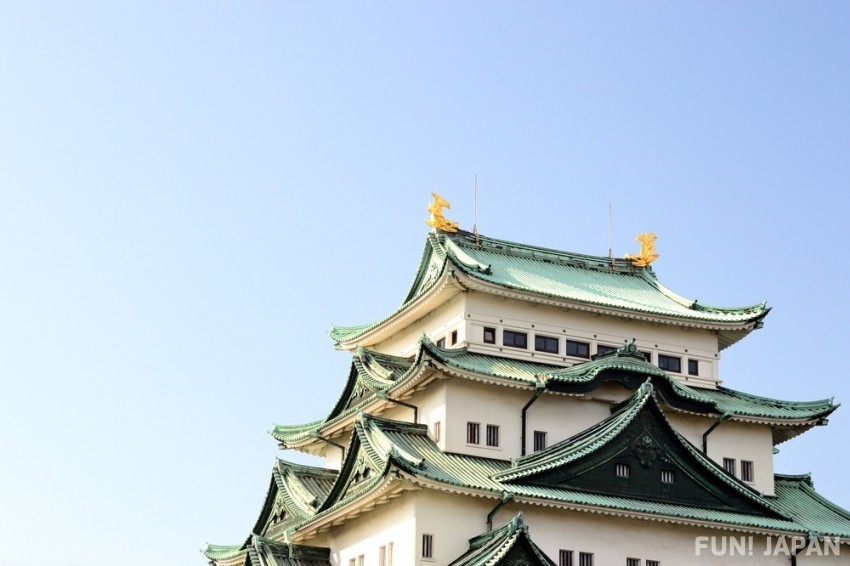
① Main Enclosure Residence
Known as the "masterpiece of early modern castle residence", the Main Enclosure Residence is divided into three areas: the "entrance and Omote-shoin" where the feudal lord conducted public affairs and met with guests, the "meeting place" where the lord met with close aides and relatives, and the "Joraku-den and Oyu-den Shoin", which was expanded in 1624 when the third shogun, Iemitsu, moved to Kyoto, and served as the shogun's lodging.
The further you go into the Main Enclosure Residence, the more "luxurious" it becomes, as it was used by people of higher rank. For example, the ceiling transitions from a low-ranking Saobuchi ceiling to a high-ranking Goutenjo ceiling, and the ceiling frame is lacquered in black, with gold leaf pressed onto the ceiling boards, making it luxuriously gorgeous.
② Gourmet Kinshachi Yokocho
A large dining facility located under Nagoya Castle. It consists of two zones: the "Yoshinao Zone", which brings together classic and long-established Nagoya cuisine dishes such as "Miso Katsu Yabaton" and "Yamamotoya Sohonten", and the "Soharu Zone", which features unique shops such as "Ankake Taro" and "Sosaku Kuchiage Tsuda".
Nagoya Castle Facility Overview
- Address: 1-1 Honmaru, Naka-ku, Nagoya City, Aichi Prefecture, 460-0031
- Business hours:
- 9:00~16:30 (Last admission to Honmaru Goten and Nishi no Maru Okura Shiro Treasure Museum is at 16:00)
- *For those wishing to enter the Honmaru Goten, please arrive at the entrance of the Honmaru Goten by 16:00, not the main gate or east gate.
- Admission fee: 500 yen
- Closed: December 29th to 31st, January 1st
- Official website: https://www.nagoyajo.city.nagoya.jp/
Access to Nagoya Castle & How to Buy Tickets
Nearest station
- Subway Meijo Line "Nagoya Castle" station, 5 minutes walk from exit 7
- City Bus Sakae 13 system (Sakae ~ Yasui-machi West) "Nagoya Castle Main Gate", Nagoya Sightseeing Route Bus "Me-guru", Kikan 2 system "City Hall" 5 minutes walk from the stop
- Meitetsu Seto Line "Higashiote" station, 15 minutes walk
Access from major stations
Nagoya Station
- Take the Nagoya City Higashiyama Line for about 5 minutes, change to the Nagoya City Meijo Line at "Sakae" station, and get off at "Nagoya Castle" station after about 4 minutes.
Sakae Station
- Take the Nagoya City Meijo Line for about 4 minutes and get off at "Nagoya Castle" station.
How to buy tickets
- ①On-site: Purchase at the ticket office
- *The castle tower has been under renovation for earthquake resistance since 2018, and the completion date is undecided. Purchase at the ticket vending machine at the east gate or main gate
- ②Online: Purchase on Asobu. Use within 3 months of purchase. No cancellations.
To the three famous castles in Japan!
All three famous castles are charming. You will be overwhelmed by the dynamism of the view from the castle tower, the moats and turrets that make up the castle, and the massive stone walls. Be sure to visit once!
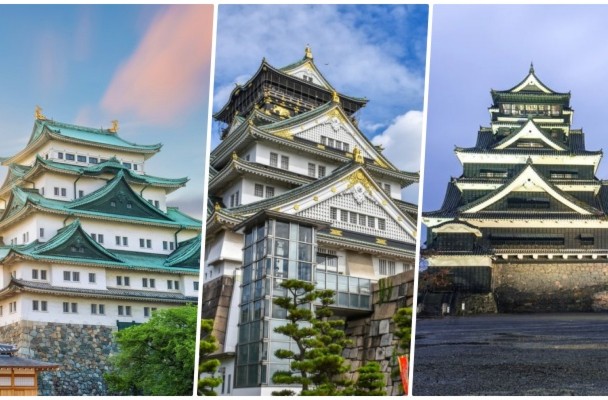

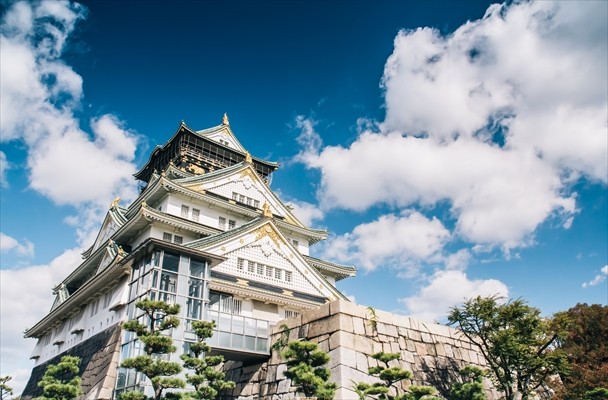

Comments